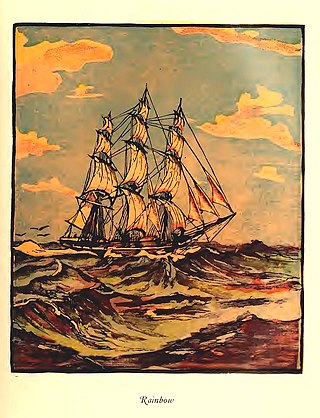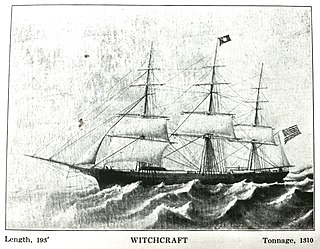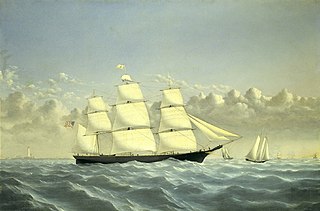
A clipper was a type of mid-19th-century merchant sailing vessel, designed for speed. Clippers were generally narrow for their length, small by later 19th-century standards, could carry limited bulk freight, and had a large total sail area. "Clipper" does not refer to a specific sailplan; clippers may be schooners, brigs, brigantines, etc., as well as full-rigged ships. Clippers were mostly constructed in British and American shipyards, although France, Brazil, the Netherlands, and other nations also produced some. Clippers sailed all over the world, primarily on the trade routes between the United Kingdom and China, in transatlantic trade, and on the New York-to-San Francisco route around Cape Horn during the California Gold Rush. Dutch clippers were built beginning in the 1850s for the tea trade and passenger service to Java.

Flying Cloud was a clipper ship that set the world's sailing record for the fastest passage between New York and San Francisco, 89 days 8 hours. The ship held this record for over 130 years, from 1854 to 1989.
The first USS Onward was a clipper in the Union Navy.

Rainbow, launched in New York in 1845 to sail in the China trade for the firm Howland & Aspinwall, was a clipper, a type of sailing vessel designed to sacrifice cargo capacity for speed.

Surprise was a California clipper built in East Boston in 1850. It initially rounded Cape Horn to California, but the vessel's owners, A. A. Low & Brother, soon found that the vessel performed well in Far Eastern waters. From that point onward the vessel spent much of her working life in the China trade, although the vessel also made three trips from the East Coast of the United States to California.

The Young America was built by William H. Webb of New York. She was launched in 1853, at the height of the clipper construction boom. She sailed in the California trade, on transatlantic routes, and made voyages to Australia and the Far East.

Witchcraft was a clipper built in 1850 for the California and China trade. She made record passages from Rio de Janeiro to San Francisco, and from San Francisco to Callao, Peru.

Carrier Dove was an 1855 medium clipper. She was one of two well-known clippers launched in Baltimore that year, the other being Mary Whitridge.
Harriet Hoxie was an 1851 clipper in the California trade. She was known for carrying cargoes of whale oil from Honolulu, and for importing the first Brown Leghorn chickens to the United States.

Herald of the Morning was one of the few clipper ships with a passage to San Francisco in less than 100 days.

Lookout was an 1853 clipper known for her passages from New York to San Francisco, and as an offshore and coastal trader in the lumber and coal trades.

Race Horse was an 1850 clipper barque. She set a record of 109 days from New York to San Francisco during the first Clipper Race around the Horn.
Antelope was a medium clipper built in 1851 in Medford, near Boston, Massachusetts. She sailed in the San Francisco, China, and Far East trades, and was known for her fine finish work and for her crew's escape from pirates. She is often called Antelope of Boston to distinguish her from the extreme clipper Antelope of New York launched in 1852.
Ganges was an 1854 clipper ship built by Hugh R. McKay in East Boston. Although she was famed for a race with Flying Cloud and Bald Eagle, the race actually never took place.

Golden West was an 1852 extreme clipper built by Paul Curtis. The ship had a very active career in the California trade, the guano trade, the coolie trade, the Far East, and Australia. She made a record passage between Japan and San Francisco in 1856.

Witch of the Wave was a long-lived extreme clipper in the California trade, with a sailing life of over 34 years. In 1851, she sailed from Calcutta to Boston in 81 days, setting a record. It was renamed the Electra in 1871.

The sailing ship Andrew Jackson, a 1,679-registered-ton medium clipper, was built by the firm of Irons & Grinnell in Mystic, Connecticut in 1855. The vessel was designed for the shipping firm of J.H. Brower & Co. to carry cargo intended for sale to participants in the California Gold Rush.

Stornoway was a British tea clipper built by Alexander Hall and Sons in Aberdeen, Scotland in 1850. She was a further development by Hall on the clippers built in Aberdeen in 1848, being larger and more obviously suited to deep sea service. She was ordered by Jardine Matheson specifically for the tea trade. In the late 1840s, tea was available earlier in the season in China, so the first ships to load had to beat to windward against the north-east monsoon to get across the China Sea. The details of the hull shape designed by Hall had this requirement in mind.

Hurricane was a large extreme clipper of 1608 tons burthen built in Hoboken, New Jersey, United States in 1851. Reputedly the most extreme clipper ever built, Hurricane proved a very fast vessel, reportedly capable of speeds of up to 18 knots (33 km/h) in ideal conditions, and establishing a number of record passages in the early years of her career.


















